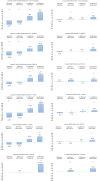The behavioural challenge of the COVID-19 pandemic: indirect measurements and personalized attitude changing treatments (IMPACT)
- PMID: 32968537
- PMCID: PMC7481714
- DOI: 10.1098/rsos.201131
The behavioural challenge of the COVID-19 pandemic: indirect measurements and personalized attitude changing treatments (IMPACT)
Abstract
Following the outbreak of COVID-19 pandemic, governments around the globe coerced their citizens to adhere to preventive health behaviours, aiming to reduce the effective reproduction numbers of the virus. Driven by game theoretic considerations and inspired by the work of US National Research Council's Committee on Food Habits (1943) during WWII, and the post-WWII Yale Communication Research Program, the present research shows how to achieve enhanced adherence to health regulations without coercion. To this aim, we combine three elements: (i) indirect measurements, (ii) personalized interventions, and (iii) attitude changing treatments (IMPACT). We find that a cluster of short interventions, such as elaboration on possible consequences, induction of cognitive dissonance, addressing next of kin and similar others and receiving advice following severity judgements, improves individuals' health-preserving attitudes. We propose extending the use of IMPACT under closure periods and during the resumption of social and economic activities under COVID-19 pandemic, since efficient and lasting adherence should rely on personal attitudes rather than on coercion alone. Finally, we point to the opportunity of international cooperation generated by the pandemic.
Keywords: COVID-19; attitude change; effective reproduction; pandemic.
© 2020 The Authors.
Conflict of interest statement
All authors declare having no competing interests.
Figures



Similar articles
-
Citizens' Adherence to COVID-19 Mitigation Recommendations by the Government: A 3-Country Comparative Evaluation Using Web-Based Cross-Sectional Survey Data.J Med Internet Res. 2020 Aug 11;22(8):e20634. doi: 10.2196/20634. J Med Internet Res. 2020. PMID: 32716896 Free PMC article.
-
Fertility patients under COVID-19: attitudes, perceptions and psychological reactions.Hum Reprod. 2020 Dec 1;35(12):2774-2783. doi: 10.1093/humrep/deaa248. Hum Reprod. 2020. PMID: 32877507 Free PMC article.
-
The need for holistic, longitudinal and comparable, real-time assessment of the emotional, behavioral and societal impact of the COVID-19 pandemic across nations.Psychiatriki. 2021 Apr 19;32(1):15-18. doi: 10.22365/jpsych.2021.010. Epub 2021 Mar 8. Psychiatriki. 2021. PMID: 33759804 English, Greek, Modern.
-
COVID-19 what have we learned? The rise of social machines and connected devices in pandemic management following the concepts of predictive, preventive and personalized medicine.EPMA J. 2020 Jul 30;11(3):311-332. doi: 10.1007/s13167-020-00218-x. eCollection 2020 Sep. EPMA J. 2020. PMID: 32839666 Free PMC article. Review.
-
Behavioural modification interventions for medically unexplained symptoms in primary care: systematic reviews and economic evaluation.Health Technol Assess. 2020 Sep;24(46):1-490. doi: 10.3310/hta24460. Health Technol Assess. 2020. PMID: 32975190 Free PMC article.
Cited by
-
Vaccination-hesitancy and global warming: distinct social challenges with similar behavioural solutions.R Soc Open Sci. 2022 Jun 15;9(6):211515. doi: 10.1098/rsos.211515. eCollection 2022 Jun. R Soc Open Sci. 2022. PMID: 35719878 Free PMC article.
-
Development and validation of a questionnaire to assess socio-behavioural impact of COVID-19 on the general population.Diabetes Metab Syndr. 2021 Mar-Apr;15(2):601-603. doi: 10.1016/j.dsx.2021.02.019. Epub 2021 Feb 18. Diabetes Metab Syndr. 2021. PMID: 33714135 Free PMC article.
-
Sex Workers and Syndemics: A Population Vulnerable to HIV and COVID-19.Arch Sex Behav. 2021 Jul;50(5):2007-2016. doi: 10.1007/s10508-021-01940-x. Epub 2021 Mar 23. Arch Sex Behav. 2021. PMID: 33759058 Free PMC article.
-
The impact of the COVID-19 pandemic on tourists' air travel intentions: The role of perceived health risk and trust in the airline.J Air Transp Manag. 2022 Aug;103:102249. doi: 10.1016/j.jairtraman.2022.102249. Epub 2022 Jun 16. J Air Transp Manag. 2022. PMID: 35755454 Free PMC article.
-
A cross-sectional survey of COVID-19: attitude and prevention practice among Syrians.Heliyon. 2022 Mar 18;8(3):e09124. doi: 10.1016/j.heliyon.2022.e09124. eCollection 2022 Mar. Heliyon. 2022. PMID: 35342826 Free PMC article.
References
Associated data
LinkOut - more resources
Full Text Sources

